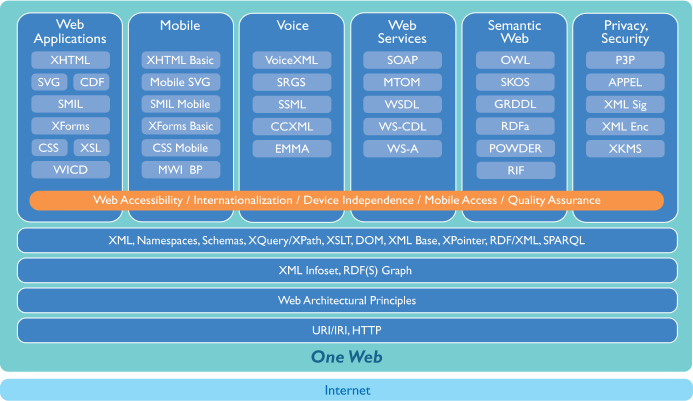W3C Overview and its Patent Policy.
Daniel Dardailler
Sophia Antipolis, 26 May 2005
Daniel Dardailler <danield@w3.org>
W3C Associate Chair, Europe
Sophia Antipolis, France
W3C Exec Summary
The World Wide Web Consortium (W3C) is an International Consortium
where Member and External organizations, a full-time technical staff, and the
public work together to lead the World Wide Web to its full
potential by developing Web standards such as protocols and
guidelines that ensure long-term growth for the Web.
- Goals: Interoperability, Universality,
Functionalities
- How: Membership fees + External grants,
- Neutral/nonforprofit, consensus based, open
participation, open results
- ~375 members, ~70 staff,
- ~50 Working Groups ~20 Coordination Groups and Interest Groups
- Based at MIT (America), ERCIM (Europe) and Keio
University (Japan) + 14 Offices
- Advisory Board, Technical Architecture Goup
- Liaisons with 40+ other standards
bodies, Accountable to the global Public
Open Results ?
A lot of debates nowadays for a common definition of Open
Standards.
My criteria:
- Transparent process
- Membership endorsement of new work
- Open participation
- Technical Consensus
- Running code/QA
- Free and Persistent Specification
- W3C Patent Policy for Web Technologies
W3C Results

W3C Patent Policy in a Nutshell
Director's Decision May 2003: The Policy affirms
and strengthens the basic business model that has driven innovation on the
Web from its inception. The availability of an interoperable, unencumbered
Web infrastructure provides an expanding foundation for innovative
applications, profitable commerce, and the free flow of information and ideas
on a commercial and non-commercial basis.
Method:
- W3C PP licensing definition
- Disclosure rules
- Exception Handling: Patent Advisory Group (PAG)
Requirements for the PP License
Requirements
for a license, (not license text itself):
- available to all
- all Essential Claims 'owned or controlled'
- field of use limitation
- reciprocity
- no fees
- defensive suspension
- no other conditions
Disclosures
Disclosure is required when actual knowledge of a patent related to
Essential Claim(s) exists.
Disclosure statements are simple (patent number, Working Group and/or
Recommendation to which it applies)
- Satisfaction of the disclosure requirement does not require that the
discloser perform a patent search
Disclosure Exemption:
- The disclosure obligation as to a particular claim is satisfied if the
holder of the claim has made a commitment to license
that claim under W3C RF
licensing requirements
- This is the default for Working Group participants
Exception Handling (PAG)
In case of a known patent that may be essential, but is not available
under W3C RF
licensing requirements, a Patent Advisory Group (PAG) will be launched to
resolve the conflict.
The PAG is an ad hoc group composed of:
- AC Representatives
- W3C staff
- Working Group Chair
- others as needed and approved by the chair
Possible PAG Conclusions
- The initial concern has been resolved, enabling the Working Group to
continue.
- The Working Group should be instructed to consider designing around the
identified claims.
- The Team should seek further information and evaluation, including and
not limited to evaluation of the patents in question or the terms under
which W3C RF licensing requirements may be met.
- The Working Group should be terminated.
- The Recommendation (if it has already been issued) should be
rescinded.
- Alternative licensing terms should be considered. The procedure for the
RAND exception must be followed.
RAND exception
- Untested so far
- Only ultima ratio if there is no other way and still lot of support
- The PAG must explain:
- why the goals can not be achieved without the patented
technology
- how the proposed licensing terms will be consistent with widespread
adoption
- The PAG must include a complete list of claims and licensing terms of
the proposed alternative
Conclusion
- A cooperation with W3C makes sense if the widest adoption possible of a
given technology is needed
- Wide adoption needs unencumbered specifications to limit the risk for
developers
- Web-culture and RAND-models don't work very well together
References
- W3C Patent Policy: http://www.w3.org/TR/patentpolicy
- Director s Decision on the Patent Policy: http://
www.w3.org/2003/05/12-director-patent-decisionpublic. html
- W3C Filings on Eolas patent challenge http://
www.w3.org/2003/10/28-906-briefing.html

